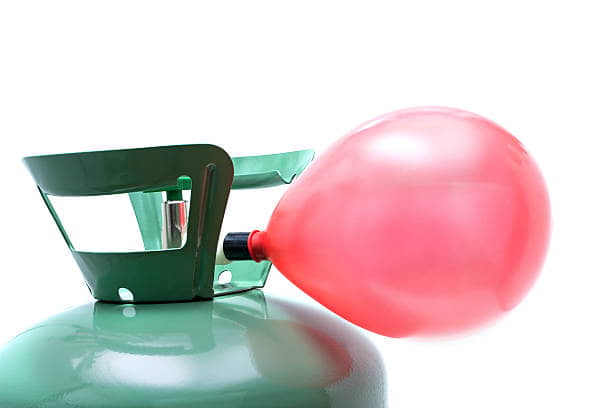Air compressors can be used for many purposes. The most common use for garage compressors is to inflate things like sports balls and tires.
What about the balloon? Everyone knows that blowing a balloon by mouth is a time-consuming process, especially when you have to inflate a large number of balloons.
That’s why finding an alternative is essential.
If compressors can inflate soccer balls, can you blow up balloons with an air compressor? Let’s find the answer!
Can You Blow Up Balloons With An Air Compressor?
The answer is yes. Using regular air compressors to inflate a balloon is possible. It is one of the efficient and convenient methods to get the job done.
But you must prepare proper hose attachments and consider a few things to avoid difficulties.
Pressure Output
Unlike car and football tires, you don’t need too much pressure to blow them up.
So even small compressors will deliver enough PSI to work well.
Most smaller machines provide a minimum pressure of 90 PSI, making them enough to fill a large number of balloons in seconds.
One of the things you need to worry about is pressure, which might over inflate and explode if you aren’t careful.
The good news is that the air tool will give you control over airflow. If your machine features a pressure regulator, you will want to set it lower than 90 PSI.
Read more: How To Inflate A Pool With An Air Compressor?
Duty Cycle And Tank Capacity
Every compressor comes with a “duty cycle”. This rating refers to how long your machine’s pump should run in a usage cycle, represented as a percentage.
For example, if you have a 50% duty cycle compressor, its pump should run 30 minutes every hour your machine is on.
If you use your machine for two minutes, its pump will rest for one minute and run for one minute.
Exceeding this rating can cause overheating and the pump to wear out quickly.
Hence, if you want to blow up dozens or hundreds of balloons quickly, you want to ensure you are not overtaxing the compressor to do the job.
A larger tank takes longer to deplete, giving the pump more time to cool. But it’s best to know the duty cycle rating of your compressor and follow it for best results.
Moisture
Moisture is one of the other factors that you also need to consider.
In most cases, water vapor will be converted into liquid when the air is compressed, and some can get into your air supply.
This is especially true if you live in one of those places with high humidity.
A little moisture won’t be a problem for many types of balloons.
However, if you use a balloon filled with bougainvillea, the small amount of moisture can also cause the confetti pieces to stick together.
If you want a moisture-free balloon, we recommend mounting a moisture trap in the airline. This device will collect any water that passes the tank.
Oil
If you use an oil-lubricated machine, a tiny amount of oil vapor might get into the chamber of your machine before entering the compressed air supply.
Although most oil models come with built-in oil separators to gather the oil content, you should invest in one in-line oil separator for additional protection.
An oil separator and moisture trap will perform the same function in most instances. So the choice is up to you.
Similar to water, oil also affects confetti inside a balloon. In worse cases, oil or oil-based lubricants can break down latex, exploding your balloon.
Noise
It would be remiss to ignore the noise level of compressors, as most models are pretty loud.
Hence, if you spend much time filling up balloons with your compressor, protecting your ears against noise is necessary.
A Detailed Guide On Inflating Balloons Using Air Compressor
Gather What You Need
- Balloons
- Air Hose
- Air Blow Gun
- Air Compressor
- Tapered rubber nozzle
Guide
- Step 1: Enable your compressor. Then give its tank time to fill.
- Step 2: Tweak the pressure regulator until your machine’s gauge reads 90 PSI or less.
- Step 3: Insert the blow gun’s tapered rubber nozzle inside each balloon and use your fingers to hold it tightly.
- Step 4: Depress the trigger of your blow gun slowly to release air into your balloon. You can hold this trigger down further to boost the process, yet, always be careful to avoid overinflating your balloon.
- Step 5: Once you have filled your balloon to a reasonable level, use your fingers to pinch the balloon nozzle closed and remove it from our blow gun’s tip.
- Step 6: Tie your balloon (it should be easy).
FAQs
Can I Blow up Balloons Using a Hair Dryer?
The short answer is yes. But your balloons will not be able to fly.
Is Blowing Balloons With Your Mouth Harmful?
In general, no. You may feel pain in your cheeks, eyes, and ears if your balloon-blowing technique is not good.
For the average, healthy person, blowing into a balloon is no more difficult than playing a wind instrument. But this doesn’t mean it is easy.
Will Balloons Float With Air Pumps?
No, balloons cannot float with an air pump. They lack that when air-filled. To float, you need to fill them with helium.
The Bottom Line
Can you blow up balloons with an air compressor? Yes, it is the simplest and fastest way to get the job done.
But you’ll need to consider some of the factors we’ve mentioned to get the best results.
Following our instructions and tips, you may never return to inflate your balloons by mouth!
Thanks for your time!




